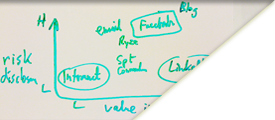“Practice” Will Highlight Behind the Curtain Enterprise Innovation with Web 2.0
 I am pleased to announce the creation of “Practice,” an exciting new Category on the Global Human Capital Journal. Practice is the first new category I’ve created since launch in 2005. It will give you behind-the-scenes insights into the innovation I am conducting with clients in my consultancy, CSRA. For example, the new CSRA Social Network Roadmap is attracting extensive attention from Fortune 1000 executives in many industries: utilities, consultancies and market research firms to name three. We will begin using the roadmap to assess, test and scale their companies’ use of social networks and Web 2.0.
I am pleased to announce the creation of “Practice,” an exciting new Category on the Global Human Capital Journal. Practice is the first new category I’ve created since launch in 2005. It will give you behind-the-scenes insights into the innovation I am conducting with clients in my consultancy, CSRA. For example, the new CSRA Social Network Roadmap is attracting extensive attention from Fortune 1000 executives in many industries: utilities, consultancies and market research firms to name three. We will begin using the roadmap to assess, test and scale their companies’ use of social networks and Web 2.0.
Practice will share the challenges that arise and how we overcome them (while respecting confidentiality, of course), so it represents a completely new dimension to these pages. During the next several months, I will modify the roadmap based on the results of its beta program, which will officially launch next month. Here I will share some of the practical understanding I’ll glean from consulting engagements in the hope that it will spare you some angst as your organization struggles with adopting such a disruptive technology/behavior combination as Web 2.0.
 I will also share insights gathered while presenting at conferences, where numerous valuable questions emerge. Moreover, Practice posts will be shorter and somewhat more informal, which is one reason that I chose to create a category for them rather than a tag. Speaking of categories and tags, weblog features are great—just like standards—there are so many to choose from! In Serendipity, the engine that runs the Global Human Capital Journal, categories and tags are both ways to “label” articles so that people can find them and access them more easily. The chief difference is that an article can only exist under one category, but it may be “tagged” with numerous tags, which appear at the bottom of the article. Therefore, categories are more defining. In this case, I am using them to define a different type of content and a different writing style and purpose, namely a focus on application rather than vision.
I will also share insights gathered while presenting at conferences, where numerous valuable questions emerge. Moreover, Practice posts will be shorter and somewhat more informal, which is one reason that I chose to create a category for them rather than a tag. Speaking of categories and tags, weblog features are great—just like standards—there are so many to choose from! In Serendipity, the engine that runs the Global Human Capital Journal, categories and tags are both ways to “label” articles so that people can find them and access them more easily. The chief difference is that an article can only exist under one category, but it may be “tagged” with numerous tags, which appear at the bottom of the article. Therefore, categories are more defining. In this case, I am using them to define a different type of content and a different writing style and purpose, namely a focus on application rather than vision.
Most important, however, you can subscribe to a category or a tag independently of anything else. For example, if you are a monthly subscriber to the GHCJ, you receive the monthly digest of articles via email. But let’s say that you would like to also be notified when an article containing a certain tag or category is published. You may do that via RSS. Hit the “XML” button next to the tag or category on the GHCJ home page, and a list of the articles under that category or that are tagged with that tag will open in your RSS reader. Bookmark it there, and place it in whatever aggregator you use.
I also hope that Practice will inspire your reactions and sharing, so I encourage you to ask questions and to share your own stories. Please let me know your thoughts!

Leave a Reply
You must be logged in to post a comment.